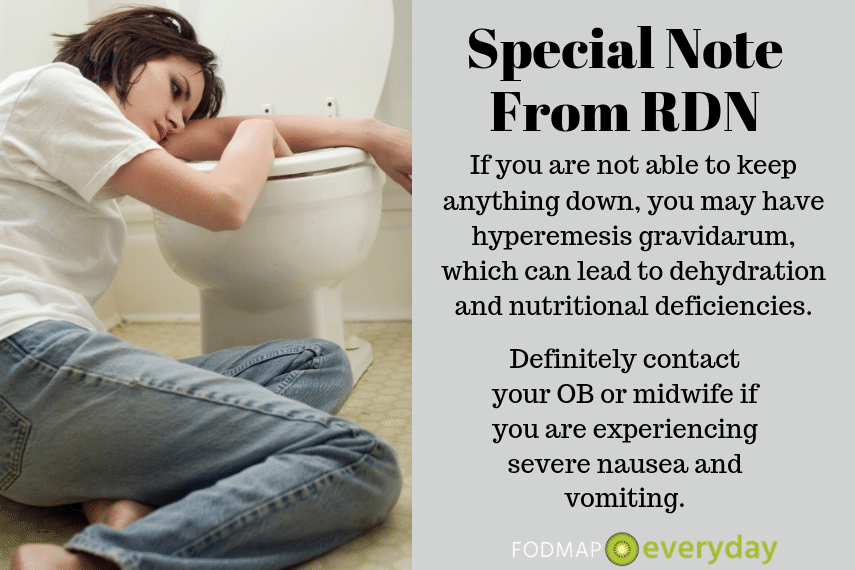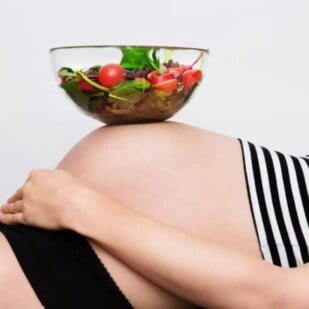Pregnancy & IBS Series: Morning Sickness
This is the second article of a four-part series addressing the very specific needs of pregnant women with IBS who are following the low FODMAP diet.
We asked Mollie Tunitsky of FitFabFODMAP to allow us to follow her during her pregnancy and we paired her with our Success Team Reproductive Dietitian Rachelle Mallik MA, RD, LDN.
Here is what you need to know about the sometimes problematic challenge of morning sickness in the first trimester.
Mollie’s Story
One of my fears of getting pregnant was the dreaded morning sickness that I would hear women talk about in graphic detail. I have always had an intense fear of throwing up since I was a little girl and the thought of having to deal with this while pregnant was enough to scare me off from pregnancy for many years.
Ironically enough, getting pregnant was not as easy as we had hoped as my husband and I ended up needing to go through IVF.
Please read Mollie’s IVF experience in our article, Pregnancy & IBS Series: PCOS, IVF, IBS & FODMAPs.
 Morning Sickness Arrives
Morning Sickness Arrives
Luckily for us, the IVF worked after the first transfer. We found out we were pregnant at 4 weeks and those first few weeks I felt fine, but beginning at about 8 weeks I started feeling the dreaded morning sickness creep up. I don’t know if it was better or worse than most, but mine was a constant all-day feeling of grossness without actually physically getting sick.
Sharing The Pregnancy News
We decided to wait until about 11 weeks to share our good news but during that time I had to put on a good face while feeling nauseous and exhausted. One positive aspect (if we can call it that!) of having IBS is that my family, friends, and coworkers were used to hearing me complain about stomach issues. It wasn’t a huge shock if I needed to cancel plans or stay home from work.
Every woman is different but for me the mornings and middle of the nights were the absolute worst for “morning” sickness, which is also when your stomach is the most empty. I found having plain carbs like cheerios, crackers or tortilla chips next to my nightstand were key to being able to grab and eat quickly. My husband would wake up in the middle of the night to me eating as he described “the loudest foods possible” but it did the trick!
Mollie’s Tips & Tricks For Morning Sickness:
- Plain carbs at hand to snack on when needed, such as Cheerios, simple crackers or tortilla chips.
- I continued to go to acupuncture treatments to deal with the nausea and increase my energy levels.
- Staying hydrated throughout the day by drinking water and watered down coconut water for electrolytes.
- Eating whatever sounded tolerable at the time. This is not the time to worry about getting all your nutrients in. It’s survival mode, people! (Rachelle’s Note: Good nutrition is important at all stages of pregnancy, but sometimes the first trimester feels like survival mode and you just eat whatever you can tolerate.)
- Sour suckers that are either specific for pregnancy or even Jolly Ranchers helped take the edge off. (Rachelle’s Note: There are a few pregnancy-related brands available that have not been lab tested but appear to be low FODMAP. They both make products containing B6, which has been clinically shown to reduce nausea in 10 to 25mg dosages 4 times/day. Look into Preggie Pops and also Pink Stork brands).
- Eating smaller meals and snacks throughout the day instead of bigger meals. Feeling overly full can instantly induce nausea.
Rachelle’s Professional & Personal Experience As A Reproductive Dietitian
What’s The Research On Morning Sickness?
Morning sickness is medically referred to as “nausea and vomiting of pregnancy” (NVP) and occurs in 75% of pregnancies.[1]That means 3 out of 4 women experience this symptom that typically lasts through the first trimester, and sometimes beyond, and can really affect quality of life. Also, morning sickness is a misnomer, since NVP can strike at any time of day, as was Mollie’s and my experience (I am currently pregnant with my second child).
Despite being common advice, high-quality evidence is lacking about the effectiveness of common dietary and lifestyle recommendations, such as eating small, frequent meals, nibbling on crackers or dry cereal, avoiding triggers such as offensive odors or spicy/greasy food, and getting fresh air.[2]However, that’s not to say they are ineffective so they’re worth trying. In addition, one study found that meals that contain protein can help reduce nausea in the first trimester.[3]
Here are some other recommendations from healthcare professionals:
- Avoid iron supplements if needed until symptoms resolve, since they may exacerbate nausea/vomiting (talk to your doctor or dietitian about this). Gummy or chewable prenatal vitamins may be better tolerated and typically lack iron.
- Take prenatal vitamins before bed with a snack.
- Vitamin B-6 (10 to 25 mg every 6 to 8hrs) and ginger (250 mg, 4 times a day) have each been shown to improve nausea, but not vomiting, compared to placebo. It is recommended that pregnant women choose ginger-containing foods over high-dose ginger supplements due to a lack of standard pharmacologic-grade ginger.
If these dietary and lifestyle interventions are not providing enough relief, your obstetrician or midwife may prescribe Diclegis, which is a combination of vitamin B-6 and doxylamine succinate (an antihistamine that’s also available over the counter).
Although Diclegis is a well-studied medication that is considered safe for pregnancy, it is recommended to try these dietary and lifestyle changes prior to taking medication for NVP. For more information on Diclegis and other medications during pregnancy and breastfeeding, check out this article.
Rachelle’s Advice For Morning Sickness
I have struggled with morning sickness in both of my pregnancies – starting on week 6 on the dot, and lasting until about 16 weeks, although nausea would still pop up on occasion after that. Feeling nauseous and exhausted for 10 weeks (2.5 months!) is not fun, and unsurprisingly was more challenging in my second pregnancy because I had a toddler to take care of. I couldn’t lay down on a couch with an ice pop and have my 2-year-old make dinner for himself!
Luckily, Diclegis helped my nausea, so I was able to enjoy more food than I remember during my first pregnancy. Unfortunately, the fatigue was worse since drowsiness is a common side effect!
Here are some nutrition and lifestyle tips that have helped me:
- Before starting Diclegis, I used to have a nausea relief pop first thing in the morning, which contained ginger and 25 mg of B6 (and only 1 g of sugar). I occasionally sucked on it like an ice pop, but usually would serve over a glass of ice and drink it cold. I also found mild, temporary relief with Ginger People Ginger Rescue chewable ginger tablets.
- Eating can help reduce nausea, even when it feels like the last thing you want to do. I try to eat regularly to avoid getting overly hungry or full. I favored dry, bland, salty or tangy foods such as whole wheat sourdough toast with peanut butter, lactose-free cottage cheese and strawberries, or cheese with whole grain crackers.
- Play around with food preparation. Roasted veggies may not be appetizing right now, but what about a crunchy salad with vinaigrette? Or savory cottage cheese instead of sweet yogurt, or homemade French toast instead of scrambled eggs, edamame instead of chickpeas?
- Having someone else cook. The idea of food can be nauseating and/or it takes too much energy to prepare, but I’m likely to eat if someone puts food in front of me. Delivery and takeout have been saviors as well; however, it’s harder to avoid FODMAPs. If you live in the Tri-State and New England region of the United States check out Epicured – the first low FODMAP prepared meal delivery service in the United States. Learn more here.
- I generally recommend whole fruit instead of juice, but I’ve found adding juice to water makes staying hydrated a lot more palatable. In the mornings, I often do a half glass of calcium-fortified orange juice with water, which helps combat some of that lower blood sugar nausea (and reduces total sugar and FODMAPs). Also, seltzer and a hearty splash of lemonade or a good old Arnold Palmer are super yummy. (PS: We have Arnold Palmer Pops and a recipe for Strawberry Arnold Palmer).
- My intuitive hunger and fullness eating cues have been off, so I serve myself reasonable portions and go for small amounts of seconds if I’m really enjoying something. One day I made the mistake of eating an entire platter of french fries at a birthday party. They were delicious in the moment, but left me bloated and nauseous for far too many hours after.
- I limit FODMAPs and make simple swaps to maintain nutrient intake (sourdough bread instead of regular wheat bread, peanut butter instead of cashew butter, lactose-free or Greek yogurt instead of regular) but I do not follow a strict low FODMAP diet during pregnancy since Monash University does not recommend it as a diet therapy during pregnancy. No long term studies have been conducted to evaluate its safety during pregnancy.
DO YOU HAVE ANY TIPS AND TECHNIQUES THAT WORKED FOR YOU DURING YOUR PREGNANCY? SHARE THEM BELOW IN COMMENTS!
What To Do About FODMAPs During Pregnancy?
If you have completed the Elimination and Challenge phases prior to pregnancy, you may continue with your personalized FODMAP diet as long as you’re not overly restricting a variety of nutritious foods.
Keep in mind, hormonal changes in pregnancy may improve or exacerbate gastrointestinal symptoms, so your tolerance to different FODMAPs may change.
See these articles for more information:
If you have not initiated the low FODMAP diet prior to pregnancy, or you have moved on to an Integrated Phase, it is advisable to work with a Registered Dietitian on a modified FODMAP diet during pregnancy. This is my recommendation based on the recommendations from Jane Muir of Monash University.
A trained dietitian can help you tailor the diet to your current needs, allowing you to reduce GI symptoms while obtaining adequate nutrition.
(Editor’s Note: Rachelle specializes in reproductive nutrition and the low FODMAP diet, and works with clients virtually). If you’re looking for a low FODMAP dietitian in your area, check out FODMAP Everyday’s directory.
CONCLUSION
The first trimester of pregnancy is an exciting and often challenging time for expecting mothers. Try implementing some of the tips above to see if that helps manage morning sickness symptoms while not exacerbating IBS.
Remember you don’t need to struggle alone – work with a qualified Registered Dietitian who understands the dietary needs of pregnancy along with the low FODMAP diet. They can support you and help you thrive during those first few months.
For other articles in this series, please refer to Pregnancy & IBS Series: PCOS, IVF, IBS & FODMAPs.
REFERENCES
[1]AND Practice Paper: Nutrition and Lifestyle for a Healthy Pregnancy Outcome (2014); https://www.uptodate.com/contents/treatment-and-outcome-of-nausea-and-vomiting-of-pregnancy
[2]Interventions for nausea and vomiting in early pregnancy. https://www.ncbi.nlm.nih.gov/pubmed/26348534
[3]Protein meals reduce nausea and gastric slow wave dysrhythmic activity in first trimester pregnancy. https://www.ncbi.nlm.nih.gov/pubmed?term=10516152
 Morning Sickness Arrives
Morning Sickness Arrives







